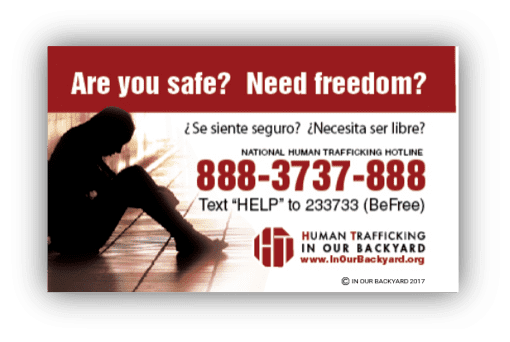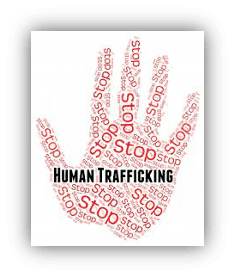Seldom do I turn down an opportunity to train. When I do, it’s usually because the topic entails funny-smelling substances that burn the skin on contact or ones that may be politically controversial. However, this one, in my humble opinion must be discussed in every community across America. That is Human Trafficking.
The practice has been around since humans walked the earth. And I’m certain many have seen news reports of the practice occurring in America. But very little discussion occurs in the dozens of newsletters, email blasts, podcasts and social meeting that caters to the fire and emergency services audience. The law enforcement community is actively pursuing the crime. Even the trucking industry has a group called Truckers Against Trafficking! But where is the fire service? Where is EMS? You’ve been to the homes or businesses where something just isn’t right or appears wrong or “off”. What do you do? Blow it off as your imagination or watching too many FBI movies? So, you dismiss it, write your report and file it under – “not my job”. Perhaps a missed opportunity to save someone’s daughter or grandson.
What is it? As described by the Department of Homeland Security, Human Trafficking (HT) is modern day slavery. Whether the individual is being held for domestic work, labor or commercial sex, everyday men, women and children are exploited in every part of the world, including here in the United States. Nearly 25 million people are affected worldwide by this $150M industry.1 Trafficking humans occurs everywhere across urban, suburban and rural communities. This ugly epidemic is a highly profitable crime and a violation of basic human rights.
Some readers may ask, “What’s Human Trafficking got to do with me? I’m just a firefighter or EMT, or fire inspector.” Because you go into people’s homes and businesses…and you see things. Sometimes those things you see may in fact be evidence of trafficking. Men are often trafficked for labor while females are most often exploited for sex. More than 17,000 child sex trafficking reports were received in 2020 in the United States.2 Your ability to spot the signs of trafficking, ability to report your “inklings” to law enforcement and your willingness to stop this crime could save the life of someone’s sister, daughter, brother or friend.
Human Trafficking Defined 
Human Trafficking is the criminal exploitation of a human being. It can be further defined as the use of force, fraud or coercion to induce another person (regardless of gender, age, ethnicity, nationality, race or socioeconomic background) to provide forced labor, domestic servitude or commercial sex. Human Trafficking should not be confused with human smuggling, which involves transporting people illegally. While the two are often interrelated, the two actions are considered separate crimes.
Indicators of Human or Sex Trafficking
There isn’t a “typical” look of a human trafficking victim or situation. Don’t rely on nationality, age, gender, socioeconomic status or race as definitive identifiers of a victim. Often the crime occurs in plain sight, requiring the responder to be situationally aware of the surroundings, and considering the totality of the call for service. By communicating with the victim and being observant of your surroundings during your scene safety sweep and patient assessment, you may develop the sense that an act of Human Trafficking may be taking place. During your interaction with the patient, resident or worker, you may discover some of the clues listed by the Department of Homeland Security’s anti-Human Trafficking Blue Campaign project:
Labor or Service Indicators
- Was the person recruited for one purpose and forced to engage in some other job?
- Is the person’s salary being garnished to pay off alleged debts?
- Was the person forced to perform sexual acts?
- Is the person a juvenile engaged in commercial sex?
- Does the person work excessively hours long and/or unusual hours?
- Is the person inadequately dressed for the situation or work they do?
Control Indicators
- Is the person in control of his/her identification and travel documents, if not who has control of the documents?
- Does the person appear to be coached on what to say? Are they with someone who appears to be controlling the situation?
- Has the person or their family been threatened with harm?
- Is the person fearful, timid or submissive?
- Has the person been threatened with deportation or law enforcement action?
- Is the person confused, afraid or do they show signs of mental or physical abuse?
- Can the person freely contact friends or family?
- Is the person allowed to freely socialize or attend religious services?
Living Conditions Indicators
- Does the person lack personal possessions or appear to have an unstable living situation?
- Does the person have freedom of movement?
- Can the person freely leave where they live?
- Are there unreasonable security measures?
- Has the person been deprived of food, water, sleep, medical care or other life necessities?
Travel Indicators
- Does the person know his/her final destination? Do they know how they will get there?
- Does the person know who is meeting him/her at the final destination?
- Is a child traveling with someone who does not seem to be their real parent or guardian?
Medical Indicators
- Does the person have scars, burns, mutilations or untreated infections?
- Is the person being prevented from or limited in providing his/her medical history?
- Is the person suffering from urinary difficulties, pelvic pain, pregnancy or rectal trauma?
- Is the person experiencing any chronic back, hearing, cardiovascular or respiratory problems?
- Does the person have poor eyesight or eye problems?
Oftentimes victim control is reliant upon the trust factor. Remember, the trafficker controls the victim without exception – money, housing, and affection, which sometimes results in an unusual relationship. The trafficker may be the victim’s parent, guardian or boyfriend. If this is the case, it may cause the victim to refuse or be reluctant to discuss his or her problems, injuries, or living conditions.
If an individual refuses to speak to you or seems fearful of something outside the immediate context of the call, or displays signs of abuse, you may have responded to a human trafficking site. When responding to work sites, take note if it appears workers live near or on the premises. Or if responding to a motel, take note if there appears to be a lot of foot traffic, often throughout the night. When encountering homeless or runaway juveniles, domestic violence or even calls to suspected gang houses where some occupants show signs of being controlled or abused, you may have unknowingly interacted with trafficked victims.
During an emergency call you may walk through the house and notice too many people living in a small space, multiple beds lining bedroom walls or other substandard conditions. If you enter a home where children are present and notice pornography in plain view or an inordinate amount of audio-visual equipment, observe the rest of the environment. Often, child victims of sex trafficking are taught that having sex with adults is normal. Take mental notes, be situationally aware of the circumstances. Watch for children who are talkative with you, but fearful of the family.

Reporting Human Trafficking
It’s never easy to report abuse, whether it’s suspected elder abuse, physical or emotional abuse, domestic abuse or suspected human trafficking. Some will be reluctant for fear of ridicule…or wrongly accusing. But, arming oneself with knowledge and a modicum of confidence, reporting your suspicions becomes easier. You may ask, “What if I’m wrong?” But, what if you’re right?
Here are some points to consider when reporting your suspicion of human trafficking:
- Be observant from the moment you step off the rig.
- Remain situationally aware – to the sights, sounds, smells, actions and reactions of all.
- Ask for documentation – individual identifications, driver licenses.
- Never use the term “Human Trafficking” in radio traffic in unsecured areas.
- Request law enforcement or backup when HT is suspected.
- Maintain non-accusatory communications with everyone.
- Maintain an unobstructed means of egress.
- Watch your partner’s six.
Below are more tips to enhance your community’s Human Trafficking awareness:
- Fire and EMS agencies should consider developing a Human Trafficking Liaison.
- Fire, EMS, law enforcement, school board and public health should collaborate to compare notes and develop policies and procedures.
- Utilize department’s social media platforms to educate the community.
- Interact with business community via social organizations: Rotary, Civitan, etcetera.
- Maintain robust relationship with counterparts via regular meetings.
- Go to dhs.gov/Bluecampaign
- Go to: polarisproject.org
- Polaris Project
- National Center for Missing and Exploited Children
Blue Campaign wallet card and keychain card will be mailed free while supplies last. Send request to: frm1@me.com with mailing address. Subject line: Blue Campaign.
